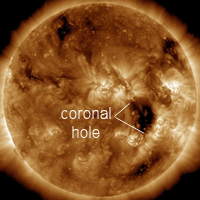QUIET SUN: With no sunspots actively flaring, the Earthside of the sun remains quiet. However, two sunspots have 'beta-gamma' magnetic fields that pose a threat for M-class solar flares. One of them, AR1836, is directly facing Earth. Solar flare alerts: text, voice.
ARCTIC LIGHTS: "Last night we had a spectacular sunset," reports photographer Frank Olsen, "but the auroras were even better." This is what the end of the day looked like from Olsen's photo-site on Andøya island, Norway:
The source of the display was a minor solar wind stream buffeting Earth's magnetic field--not hard enough to trigger a full-fledged geomagnetic storm, but enough to spark auroras visible against the darkening late-summer sky.
More lights are in the offing. A CME that left the sun yesterday will sail past Earth on Sept. 6th. The cloud won't hit our planet, but Earth will likely pass through the CME's wake, setting the stage for a new round of Arctic auroras. Aurora alerts: text, voice.

Solar wind
speed: 428.4 km/sec
density: 3.5 protons/cm3
explanation | more data
Updated: Today at 1556 UT
X-ray Solar Flares
6-hr max: B8 1421 UT Sep03
24-hr: B8 1421 UT Sep03
explanation | more data
Updated: Today at: 1500 UT
![]()
Daily Sun: 03 Sep 13
The Earthside of the sun is quiet. There is, however, a slight chance of M-class solar flares from AR1834 and AR1836 Credit: SDO/HMI
![]()
Sunspot number: 84
What is the sunspot number?
Updated 03 Sep 2013
Spotless Days
Current Stretch: 0 days
2013 total: 0 days (0%)
2012 total: 0 days (0%)
2011 total: 2 days (<1%)
2010 total: 51 days (14%)
2009 total: 260 days (71%)
Since 2004: 821 days
Typical Solar Min: 486 days
Update 03 Sep 2013
The Radio Sun
10.7 cm flux: 106 sfu
explanation | more data
Updated 03 Sep 2013
![]()
Current Auroral Oval:
Switch to: Europe, USA, New Zealand, Antarctica
Credit: NOAA/POES
![]()
Planetary K-index
Now: Kp= 2 quiet
24-hr max: Kp= 2 quiet
explanation | more data
Interplanetary Mag. Field
Btotal: 7.0 nT
Bz: 4.3 nT north
explanation | more data
Updated: Today at 1333 UT
![]()
Coronal Holes: 03 Sep 13
Solar wind flowing from the indicated coronal hole should reach Earth on Sept. 5-6. Credit: SDO/AIA.





